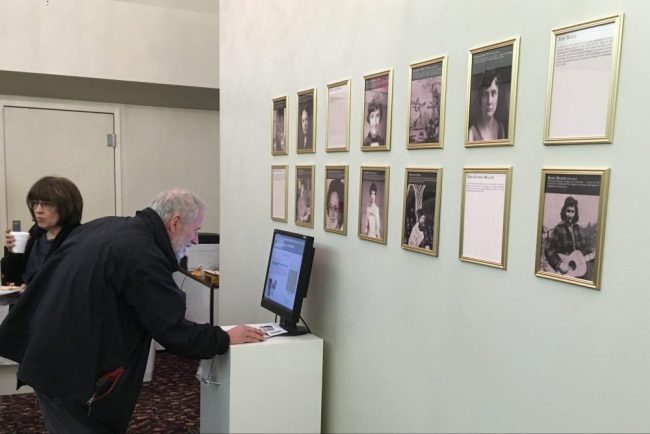
Visitors exploring the West Virginia Women’s Heritage Trail on Clio at Arts Monongahela in Morgantown, West Virginia.
As history professionals, getting publicity for our sites and programs is a constant challenge. Social media offers the potential to reach new audiences by leveraging our current network of supporters. But how else might we expand our outreach efforts? While mobile devices suffer from a number of limitations, these little machines offer some incredible possibilities, such as the capacity to reach people at the moment when they are most curious about the history that surrounds them.
Clio is a free educational website and mobile application created by historians at Marshall University. Similar to other leading mobile applications that connect the public to nearby points of interest, Clio uses GPS and is simple and intuitive. What makes Clio unique is its focus on historical and cultural sites and its mission to provide detailed information and links to related primary and secondary sources. Organizations and local historians can create individual entries and complete walking tours that connect users to reliable information about nearby monuments, markers, buildings, and museums. To meet Clio’s non-profit mission, each entry should include links to related books and articles as well as reliable websites. Entries can also embed media such as oral histories, videos, and photographs with captions. Clio is a non-profit and free for everyone, and its designers welcome public historians to use the platform to drive physical traffic to museums and virtual traffic to museum websites.
There are 20,000 people using Clio each month as they travel. In addition to being a fun way to discover nearby history, this is also a great way for small museums to reach the public. Over the past handful of years, academic and local historians have authored thousands of entries and created hundreds of walking tours throughout the United States. Many of these entries promote museums directly by providing links to museum websites. Entries also connect people to related books, articles, and digital resources immediately after they read the entry.
Rather than aggregate information from existing websites, Clio hopes to offer an original and concise entry that introduces readers to a museum and its collections. After an introduction, Clio includes a “backstory” section where readers can learn about the history of a museum, highlights of the collection, and other information that demonstrates how a museum has changed over time. From my perspective, one of the most exciting possibilities for a mobile application such as Clio is the capacity for museums professionals to provide the backstory behind a museum, from the founding to efforts to preserve and expand their collections. I encourage all of my colleagues to author an original entry in Clio that will connect the public to your museum and its history.

Clio offers special accounts for museums that make it easy for a team to create, review, edit, and publish entries for a variety of historical and cultural sites. After creating entries, it only takes a few moments to build a walking tour and there are videos that guide users through each step of creating an entry and building a walking tour. When it comes to markers and monuments, Clio might also provide more detailed information than might be carved into stone or metal. In addition, Clio can provide multiple perspectives on the past and show how historical monuments have been interpreted over time. Such an approach may be especially relevant for those seeking to offer historical context for controversial monuments or previous interpretive decisions.
Clio entries and tours can augment museum exhibitions. Last March, for example, I served on the curatorial team for a Women’s History Month exhibition at an art gallery. In addition to featuring works of art from local female artists, we also created a West Virginia Women’s Heritage Trail using Clio. This provided an interactive component of the exhibition that encourages users to provide feedback. With this feedback, our team was able to update the heritage trail as patrons and local historians suggested additional information and historical sites for possible inclusion. While the exhibition ended, the trail continues to serve as an educational resource and we hope to create additional trails that reflect the history of our state.

Opening reception for IN.Exclusive: An Exhibit and Event Series Dedicated to West Virginia Women at Arts Monongahela.
Clio’s lead creator, Dr. David Trowbridge, hopes that Clio will provide a platform for more people to discover local museums. Trowbridge also hopes that Clio can encourage people to discover new information about familiar places. “Too often, we allow mobile devices to distract and disconnect us from the world around us,” Trowbridge explained, but they can also connect us to information about that world. “I built Clio as a fun way to engage with nearby history, but I also see it as way to cultivate our natural curiosity and encourage a more active view of the world around us.”
Clio has already inspired thousands of unexpected discoveries and unplanned diversions for locals and travelers alike. I hope that my fellow museum professionals and local historians will add entries throughout their communities that can help spread awareness of museums and encourage our neighbors and guests to discover the history that surrounds us.



